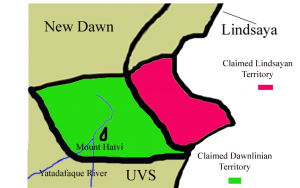The Northern-Southian Territorial Dispute
The Northern-Southian Territorial Dispute was a disagreement between two countries, New Dawn and The United Villages of Southia, as to who had control over a section of present-day northern UVS. The dispute eventually grew to include The Democratic-Republic of Lindsaya as well, and was the main cause of The First New Southian War, in which the UVS defeated the combined northern forces to gain the disputed territory. During the dispute and throughout the war, the two sides developed a hatred of each other, committing numerous crimes and unspeakable acts against each other. Some of this hatred still lingers today, as the UVS based Hei Hei Hatvists terrorist group specifically targets New Dawn, as well as the two countries not having diplomatic relations as well as closed borders and economic tariffs.
Disputes and Origin
In 1842, the disputed land between the two countries of New Dawn and the UVS were considered by most of the world as unorganized territory, belonging to neither of the two countries. However, in 1843, the UVS government decided that the territory had more UVS settlers than New Dawn ones, and, hungry for land to bring the UVS (And possibly his political career) into worldwide fame, Emperor Jakile Vitanmas declared the territory to be a Hatvist Region, or sort of state, within the UVS, called Porutinnias.
His country immediately approved of the decision, mainly because they believed the area to be rightfully theirs, as the sacred book for Hatvism, the Kitabahid, recognized Mount Hatvi as well as The Yatadafaque River to be holy sites. Both of these landmarks were in claimed territory, and the citizens were glad to see the citizens of New Dawn, who were overwhelmingly followers of Christianity, get pushed out. To enforce his claim, Vitanmas sent 1,000 new settlers to the area, along with hundreds of UVS flags, one of which was planted on Mount Hatvi by The Gousthack Legion. These moves were seen as a sign of aggression and hostility by New Dawn, and the country sent its own group of settlers, numbered at 2,000, to the territory, as well as sending a group, called the Disciples of the New Dawn, up the mountain to replace the UVS flag with a Dawnlinian flag.
This flag removing and flag replanting went on for a staggering 13 years, with the two groups going up the mountain a combined 54 times. In 1854, the two governments still remaining indecisive as to the territory, a new king was crowned in The Democratic-Republic of Lindsaya, King James Apple III. King James was looking to expand the land of his country, which had been living in the same borders for nearly 300 years, to grow the population as well as gain new resources. He also had a strong relationship with New Dawn's government, and in 1855 New Dawn recognized Lindsaya's new claim to a region in northeast UVS along the coast, and Lindsaya recognized the Dawnlinian claim of the mountain territory. The two nations also began running cooperative military drills extremely close to the UVS borders.
Finally, this aggression was too much for the UVS, and the next year, they sent the last Legion up the mountain to plant the flag, and declared war in 1856, called The First New Southian War.
